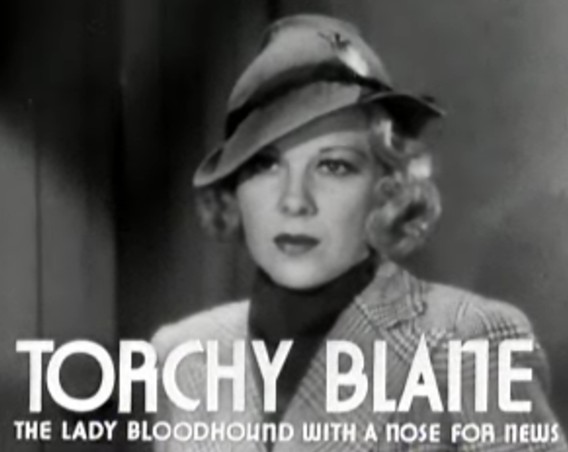The image of a truth-seeking, fearless, tough-minded female reporter was a liberating role model for women during the mid-20th century when movies and radio were the predominant entertainment media.
Torchy Blane, featured in nine Hollywood movies from 1937 to 1939 and played by three different actresses, was a fictional newspaper reporter who was also a tough-talking, crime-solving detective.
 Glenda Farrell in Smart Blonde Trailer | Public Domain
Glenda Farrell in Smart Blonde Trailer | Public DomainIn the 1939 episode, “Torchy Blane Runs for Mayor,” the reporter, played at that time by Glenda Farrell, exposed corruption in a city government where the mayor was taking money from the mob. In a plot twist with modern-day implications, the mayor threatens to withdraw advertising from any newspapers who criticize him, but Torchy finds a paper that will publish the truth.
Cited by one journalism researcher as “the most famous fictional journalist you’ve never heard of,” Torchy Blane may have been the most well-known fictional reporter of her time - more popular than either Lois Lane or Brenda Starr, two other fictional women reporters in the popular media of the time (see IJPC notes).
Actress Glenda Farrell is most prominently associated with the character, but Torchy Blane was also played by Lola Lane in one movie and her name served as the one of the inspirations for the reporter Lois Lane in the Superman comics and films (Turner Classic Movies, April 24, 2019). You can read a summary of all Torchy Blane films here.
 Watch on YouTube
Watch on YouTubeLongstanding gender roles have strongly influenced the images of women reporters in movies. One recent study of 180,000 sentences in movie plots between 1940 and 2019 showed that women characters have been primarily associated with themes of romance, sexual relationships, and weddings, while male characters have more diverse roles and portrayals (Gender Stereotypes in Hollywood Movies and Their Evolution Over Time: Insights from Network Analysis. Big Data and Cognitive Computing, 2022).
In the case of news reporters, some female characters challenged gender stereotypes. One example is Jane Arden who appeared in newspapers for 41 years from 1927 to 1986. She was referred to in print as a "spunky girl reporter" and on radio as a "fearless girl reporter" (Wikipedia) and was the central character in the 1939 movie, "The Adventures of Jane Arden." Her uncover investigative work helps the police catch a gang of jewel smugglers. View the original trailer for the film here. Jane Arden was another prototype for Lois Lane, the newswoman reporter in the Superman movies.
Over time and many movies, the character of Lois Lane has evolved from a woman who had to be rescued by a man to an independent, in-charge, change-seeking journalist. Women reporters were also portrayed on TV as independent figures in the 1970s on The Mary Tyler Moore Show and Murphy Brown, although the roles were situated in comedies where the news business was broadly played for laughs.
Women reporters have also been shown complicated profesional situations. "Meet John Doe" (1941) stars a woman newspaper columnist (Barbara Stanwyck), who, on the verge of being fired, recruits a drifter (Gary Cooper) to impersonate a non-existent person that people across the nation begin to treat as a celebrity, all as a scheme to generate more sales for her newspaper. Although the main characters appear to change their attitudes and regret their actions at the end of the story, the film reveals the power of deception and manipulation in the business of selling newspapers ("Meet John Doe" Shows the Darkness of American Democracy, Kristin Hunt, 2019).
Looking at media today, do you see any women news reporters in recent Hollywood movies or current television or streaming shows (for example, Jennifer Aniston and Reese Witherspoon on The Morning Show on Apple TV+)? How do they compare with the image of a strong-minded reporter like Torchy Blane?
In this activity you will design a poster for a modern-day movie, TV show, podcast, or streaming series about a strong, independent, ethical, truth-seeking woman journalist.
Activity: Design a Poster for a Movie, TV Show, Podcast, or Streaming Series about a Woman Journalist
- Use the Teacher and Student Guide to Critically Analyzing Images to examine the design techniques used in posters for Torchy Blane movies, such as Torchy Blane Playing with Dynamite.
- Then, spend 10-15 minutes free writing your thoughts for a movie, TV show, podcast, or streaming series about a woman journalist. Consider the following prompts:
- Who would be the characters?
- What would be the setting?
- What would be the storyline?
- What are the main tensions/conflicts facing the characters?
- How would the main character balance the demands of presenting news as objective and truthful at a time when entertainment and fake news spread faster than truthful news?
- Finally, design a digital or print poster for the movie, TV show, podcast, or streaming series.
Additional Resources